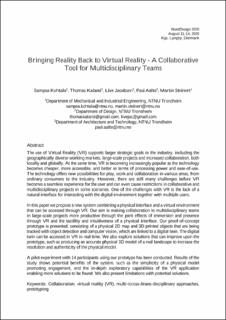Bringing Reality Back to Virtual Reality - A Collaborative Tool for Multidisciplinary Teams
Kohtala, Sampsa Matias Ilmari; Kaland, Thomas Colin Guo; Jacobsen, Live; Aalto, Pasi Olav; Steinert, Martin
Chapter
Accepted version

Åpne
Permanent lenke
https://hdl.handle.net/11250/2682330Utgivelsesdato
2020Metadata
Vis full innførselSamlinger
- Institutt for design [1054]
- Institutt for maskinteknikk og produksjon [3976]
- Publikasjoner fra CRIStin - NTNU [37221]
Originalversjon
10.35199/NORDDESIGN2020.38Sammendrag
The use of Virtual Reality (VR) supports larger strategic goals in the industry, including the geographically diverse working markets, large-scale projects and increased collaboration, both locally and globally. At the same time, VR is becoming increasingly popular as the technology becomes cheaper, more accessible, and better in terms of processing power and ease-of-use. The technology offers new possibilities for play, work and collaboration in various areas, from ordinary consumers to the industry. However, there are still many challenges before VR becomes a seamless experience for the user and can even cause restrictions in collaborative and multidisciplinary projects in some scenarios. One of the challenges with VR is the lack of a natural interface for interacting with the digital environment together with multiple users. In this paper we propose a new system combining a physical interface and a virtual environment that can be accessed through VR. Our aim is making collaboration in multidisciplinary teams in large-scale projects more productive through the joint effects of immersion and presence through VR and the tactility and intuitiveness of a physical interface. Our proof-of-concept prototype is presented, consisting of a physical 2D map and 3D printed objects that are being tracked with object detection and computer vision, which are linked to a digital twin. The digital twin can be accessed in VR in real time. We also explore solutions that can improve upon the prototype, such as producing an accurate physical 3D model of a real landscape to increase the resolution and authenticity of the physical model. A pilot experiment with 14 participants using our prototype has been conducted. Results of the study shows potential benefits of the system, such as the simplicity of a physical model promoting engagement, and the in-depth exploratory capabilities of the VR application enabling more solutions to be found. We also present limitations with potential solutions.